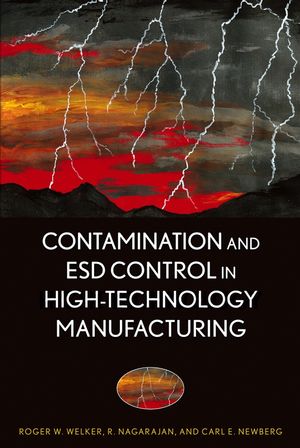Contamination and ESD Control in High-Technology ManufacturingISBN: 978-0-471-41452-0
Hardcover
514 pages
September 2006, Wiley-IEEE Press
 This is a Print-on-Demand title. It will be printed specifically to fill your order. Please allow an additional 15-20 days delivery time. The book is not returnable.
|
||||||
1 FUNDAMENTALS OF CONTAMINATION CONTROL.
1.1 Introduction.
1.2 Glossary of Contamination Control Terms.
1.3 Specifying Contamination in Air and on Surfaces.
1.4 Sources of Contamination.
1.5 Contamination Control Requirements.
1.6 Pertinent Standards.
References and Notes.
Additional Reading.
2 FUNDAMENTALS OF ESD CONTROL.
2.1 Introduction and Historical Perspective.
2.2 Glossary of Electrostatic Charge Control Terms.
2.3 Sources of Electrostatic Charge.
2.4 Requirements of ESD Control.
2.5 Building the ESD-Safe Workplace.
2.6 ESD Controls for People.
2.7 Consumables and Accessories.
2.8 Personnel Equipment and Procedures for Its Use.
2.9 Transportation of ESD-Sensitive Products.
2.10 Inspections and Record Keeping.
2.11 ESD Control Program.
2.12 ESD and Contamination Control.
2.13 Useful Reference Standards.
References and Notes.
3 SAMPLING AND ANALYSIS METHODS.
3.1 Introduction.
3.2 Classification of Analysis Methods.
3.4 Organic Contamination Analysis Methods.
3.5 Ionic and Inorganic Contamination Analysis Methods.
3.6 Electrostatic Discharge Methods.
3.7 Numerical Simulation.
3.8 Algebraic Predictive Modeling.
3.9 Statistical Analysis Methods.
Additional Reading.
References and Notes.
4 FACILITIES DESIGN: CONTAMINATION- AND ESD-SAFE WORK AREAS.
4.1 Introduction.
4.2 Basics of Cleanroom Design.
4.3 Cleanrooms.
4.4 Cleanroom Construction and Operating Costs.
4.5 Modern Energy-Saving Approaches.
4.6 Other Design Considerations.
References and Notes.
5 GETTING CLEAN PARTS AND GETTING PARTS CLEAN.
5.1 Introduction.
5.2 Historical Perspective.
5.3 Gross and Precision Cleanliness Protocols.
5.4 Design for Manufacturability and Cleanability.
5.5 Process Design Guidelines.
5.6 Cleaning Processes.
5.7 Drying Processes.
5.8 Cost of Cleaning.
5.9 Vendor Process Contamination Checklist.
5.10 Case Studies: Cleaning Equipment and Cleaning Process Design.
5.11 Details on the Clean–Then Assemble and Assemble–Then Clean Procedures.
5.12 Particle Size Distributions.
5.13 Tool Part Cleanliness.
References and Notes.
6 TOOLING DESIGN AND CERTIFICATION.
6.1 Introduction.
6.2 Contamination and ESD Control Requirements.
6.3 Maintenance Requirements.
6.4 General Design Alternatives.
6.5 Materials.
6.6 Surface Treatments.
6.7 Selection and Evaluation of Components.
6.8 Tool and Workstation Layout.
6.9 Cleanroom Certification of Automated Tooling.
References and Notes.
Additional Reading.
7 CONTINUOUS MONITORING.
7.1 Introduction.
7.2 Continuous Contamination Monitoring.
7.3 Continuous Monitoring of Manufacturing.
7.4 Evaluation of In Situ Monitoring in an Aqueous Cleaning Application.
7.5 Antennas for Electrostatic Charge Monitoring.
References and Notes.
8 CONSUMABLE SUPPLIES AND PACKAGING MATERIALS.
8.1 Introduction.
8.2 Cleanroom and ESD Gloves.
8.3 Functional vs. Nonfunctional Testing.
8.4 Glove Use Strategies.
8.5 Initial Qualification vs. the Need for Ongoing Lot Certification.
8.6 Glove Washing.
8.7 ESD Performance of Gloves.
8.8 Glove Laundering.
8.9 Wipers and Swabs.
8.10 Reusable and Disposable Packaging Materials.
8.11 Facial Coverings.
References and Notes.
9 CONTROLLING CONTAMINATION AND ESD FROM PEOPLE.
9.1 Introduction.
9.2 People as a Source of Contamination.
9.3 Typical Gowning Protocols.
9.4 Procedures for Entering a Cleanroom.
9.5 Behavior in a Cleanroom.
9.6 Procedures for Exiting a Cleanroom.
9.7 Relationship between Attire and Class Achieved.
9.8 Procedures for Entering an ESD-Safe Work Area.
9.9 Garments and Laundry Services.
References and Notes.
10 LAYOUT OF CHANGE ROOMS.
10.1 Principles of Efficient Change Room Design.
10.2 Case Studies: Change Rooms.
10.3 Entering the Cleanroom.
10.4 Exiting the Cleanroom.
10.5 Other Considerations.
References and Notes.
11 PROCEDURES AND DOCUMENTATION.
11.1 Hierarchy of Documents and Audits.
11.2 Operator Self-Check.
11.3 Noninstrument Audits.
11.4 Instrument Audits.
11.5 Independent Audits.
11.6 Managing Use of the Audit Scorecard.
11.7 Typical Survey.
11.8 Case Study: Broken Magnet Procedure.
Reference.
INDEX.



